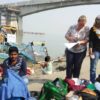As Californians work toward a publicly stated goal of carbon neutrality by 2045, residents of the Golden State stand to reap such additional benefits as cleaner air, widespread improvements in public health and related cost savings, according to researchers at the University of California, Irvine. But the extent to which these plusses will be shared by all stakeholders, including historically underserved communities, remains a matter for debate.
In a paper published recently in Nature Communications, an interdisciplinary team of UCI scientists quantified the health co-benefits of different decarbonization scenarios. One involved powering buildings using renewable electricity and operating cleaner trucks to meet the state greenhouse gas targets. The second option centered on using renewable gas instead of renewable electricity for building energy and employing even more cleaner trucks to meet the greenhouse gas goals, as utilizing renewable gas in buildings does not provide as much reduction in carbon as renewable electricity, according to the researchers.
Through an analysis combining physical, epidemiological and statistical models, the team from UCI’s Advanced Power and Energy Program demonstrated that while greener buildings would provide a roughly 15 percent improvement in health outcomes for the broad state population, elimination of greenhouse gases (and other forms of air pollution) from heavy-duty, over-the-road trucking would more directly benefit low-income Californians who live and work in closer proximity to the state’s ports, industrial facilities and highways.
“Socially and economically disadvantaged communities are disproportionally impacted by air pollution,” said senior co-author Scott Samuelsen, founding director of APEP and UCI professor of mechanical, aerospace and environmental engineering. “As California commits to a carbon-neutral future, it’s prudent to assess the effect of climate policy on urban air quality for the general population and, especially, disadvantaged communities.”
In all cases, air quality improved in lockstep with the implementation of climate policy, he said. The results, however, varied depending on the technology- and fuel-switching options adopted in the individual end-use sectors. Such policy tradeoffs highlight the importance of considering environmental justice implications in the development of climate mitigation approaches, Samuelsen stressed.
Co-author Steve Davis, UCI professor of Earth system science, said that study findings prove that air quality health co-benefits can, in principle, substantially offset costs associated with programs tackling global warming, a further rationale for progressively pursuing climate-energy policy.
“Despite differences in the distribution of health benefits, our work shows that decarbonization will consistently be a powerful force for equity,” Davis said. “The challenge of meeting California’s carbon neutrality goal by 2045 will require large emissions reductions by all sectors of the economy. The electrification of both buildings and heavy-duty vehicles should be prioritized due to the benefits outlined in our study.”
More information:
Shupeng Zhu et al, Decarbonization will lead to more equitable air quality in California, Nature Communications (2022). DOI: 10.1038/s41467-022-33295-9
Provided by
University of California, Irvine
Citation:
Greener trucking would benefit disadvantaged Californians more than greener buildings (2022, October 12)



